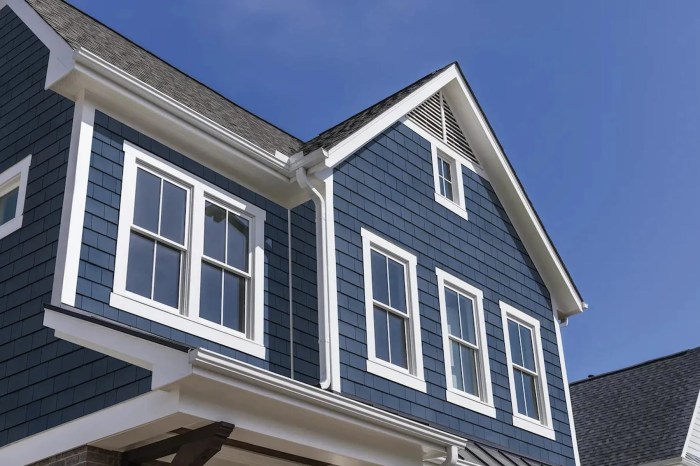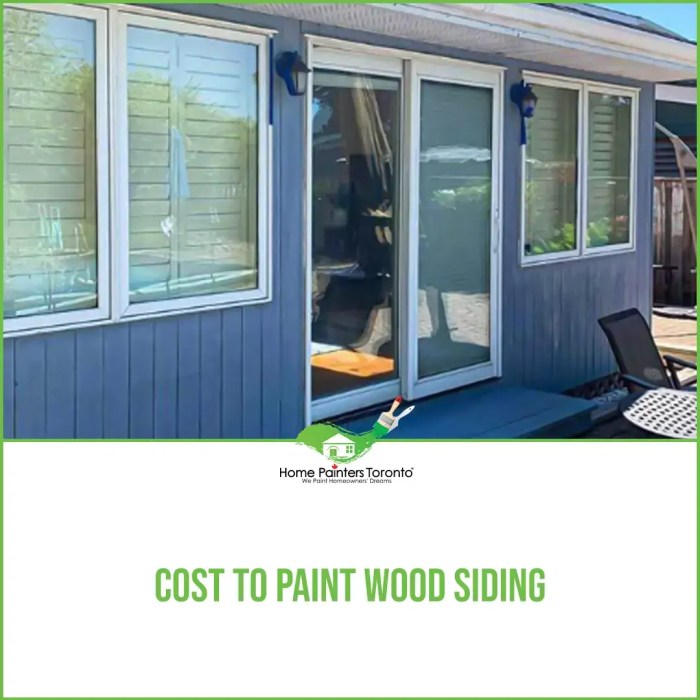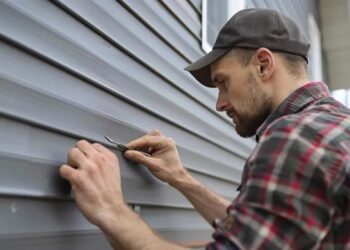Painting wood siding cost delves into the intricacies of budgeting for a project that involves revamping the exterior of your home. From the type of paint used to the labor expenses incurred, this guide offers a comprehensive look at the financial aspects of enhancing your property's curb appeal.
Exploring the key factors that influence the overall cost, understanding the time estimates involved, and dissecting the material expenses required are just a few highlights of what this discussion entails.
Cost Factors for Painting Wood Siding

When considering the cost of painting wood siding, several key factors come into play that can impact the overall price of the project.
Size of the Project
The size of the project is a significant factor in determining the cost of painting wood siding. Larger homes or buildings with extensive siding will naturally require more paint and labor, leading to a higher overall cost.
Type and Quality of Paint
The type and quality of paint chosen for the project also play a crucial role in pricing. Higher quality paint brands or specialized finishes may come at a higher price point, impacting the total cost of the painting job.
Surface Preparation
Proper surface preparation is essential for a successful paint job and can significantly affect costs. If the wood siding requires extensive cleaning, sanding, or repairs before painting can begin, this additional labor and materials will contribute to the overall expenses of the project.
Labor Costs and Time Estimates
When it comes to painting wood siding, labor costs and time estimates play a significant role in determining the overall project expenses.Painting wood siding requires skilled labor to ensure a high-quality finish that can withstand the elements. Labor costs can vary depending on the experience and expertise of the painters, as well as the complexity of the project.
Labor Costs
- Professional painters typically charge between $25 to $50 per hour for wood siding painting.
- The total labor cost for painting wood siding on an average-sized house can range from $1,500 to $3,000.
- DIY painting can save on labor costs, but it requires a significant time investment and may not result in the same level of quality as professional work.
Time Estimates
- On average, painting wood siding on a typical house can take anywhere from 3 to 5 days to complete.
- Factors such as weather conditions, size of the house, and the condition of the wood siding can influence the time needed to finish the project.
Complexity of Wood Siding Design
- More intricate wood siding designs, such as shingles or decorative trims, can increase labor costs due to the additional time and effort required to paint these details.
- Straightforward wood siding designs with fewer nooks and crannies are generally quicker and easier to paint, resulting in lower labor costs.
Hiring Professionals vs. DIY Painting
- While hiring professionals may cost more upfront, it ensures a high-quality finish and saves you time and effort.
- DIY painting can be a cost-effective option, but it requires careful preparation, skill, and time commitment to achieve satisfactory results.
- Consider your budget, timeline, and skill level when deciding between hiring professionals or tackling the project yourself.
Material Costs Breakdown

When it comes to painting wood siding, material costs play a significant role in determining the overall budget for the project. Understanding the breakdown of material costs can help you make informed decisions and optimize your expenses.Primer, paint, sealers, and other materials are essential for painting wood siding.
Each of these materials comes with its own cost, which can vary depending on the brand and quality you choose. It's important to consider both the upfront cost and the long-term durability of the materials when making your selection.
Cost of Primers, Paints, and Sealers
- Primer: A good quality primer is crucial for ensuring proper adhesion and longevity of the paint. Prices for primers can range from $20 to $50 per gallon, depending on the brand and type of primer.
- Paint: The cost of paint varies widely based on the brand, quality, and finish. High-quality exterior paint can cost between $30 to $70 per gallon, while premium paints can go up to $100 or more per gallon.
- Sealers: Sealers are essential for protecting the wood siding from moisture and UV damage. Prices for sealers typically range from $25 to $60 per gallon, depending on the type and brand.
Differences in Costs Between Paint Brands and Qualities
- Lower-priced paints may save you money upfront, but they may require more frequent repainting due to lower durability.
- Higher-quality paints offer better coverage, color retention, and longevity, reducing the need for repainting in the long run.
- Consider the climate and exposure of your wood siding when choosing paint quality to ensure it can withstand the elements effectively.
Tips for Cost-Effective Material Choices
- Look for sales or promotions from reputable paint brands to get quality materials at a discounted price.
- Consider using a combination of mid-range and high-quality materials to balance cost and durability.
- Consult with a professional painter or paint supplier for recommendations on cost-effective materials that meet your specific needs.
Additional Costs and Considerations
When painting wood siding, there are several additional costs and considerations to keep in mind to ensure the project stays within budget and runs smoothly.One of the key additional costs to consider is the need for equipment rentals. Depending on the size of the project and the tools you already have on hand, you may need to rent equipment such as ladders, scaffolding, or power washers.
These rental costs can add up quickly and should be factored into your overall budget.Weather conditions and seasons can also have a significant impact on painting costs. Extreme heat or cold, high humidity, or rainy weather can all affect the paint's drying time and overall quality of the finish.
It's important to plan your painting project during a time of year when the weather is mild and dry to ensure the best results and avoid costly delays.To save on costs during the painting process, consider some cost-saving measures or strategies.
For example, you can opt for a lower-priced paint brand or choose to do some of the prep work yourself, such as cleaning and sanding the wood siding. Additionally, getting multiple quotes from different contractors and comparing prices can help you find the best deal for your budget.
Choosing the Right Paint
When considering additional costs, choosing the right paint for your wood siding can make a big difference in the overall project cost. Opting for high-quality paint may be more expensive upfront, but it can save you money in the long run by lasting longer and requiring fewer touch-ups or repaints.
Look for paints that are specifically formulated for exterior wood surfaces and offer protection against the elements.
Professional vs. DIY Painting
Another consideration is whether to hire a professional painter or tackle the project yourself. While hiring a professional can ensure a high-quality finish, it comes with additional labor costs. On the other hand, painting the wood siding yourself can save on labor costs but requires time, effort, and skill to achieve professional results.
Consider your budget, timeline, and skill level before deciding which option is best for you.
Closing Summary
As you wrap up your journey through the realm of painting wood siding cost, remember that investing in this endeavor can not only elevate the aesthetic appeal of your home but also potentially increase its market value. With careful planning and informed decision-making, you can transform your property into a stunning masterpiece that stands the test of time.
Quick FAQs
What are the key cost factors for painting wood siding?
Key cost factors include the size of the project, type and quality of paint, and the extent of surface preparation needed.
How do labor costs vary for painting wood siding?
Labor costs depend on the complexity of the siding design and whether you hire professionals or opt for a DIY approach.
What material costs are involved in painting wood siding?
Material costs include primers, paints, sealers, and other necessary materials. The choice of paint brand and quality can also impact expenses.
Are there additional costs to consider when painting wood siding?
Additional costs may arise from equipment rentals, weather conditions affecting the project, and potential cost-saving strategies during the painting process.














